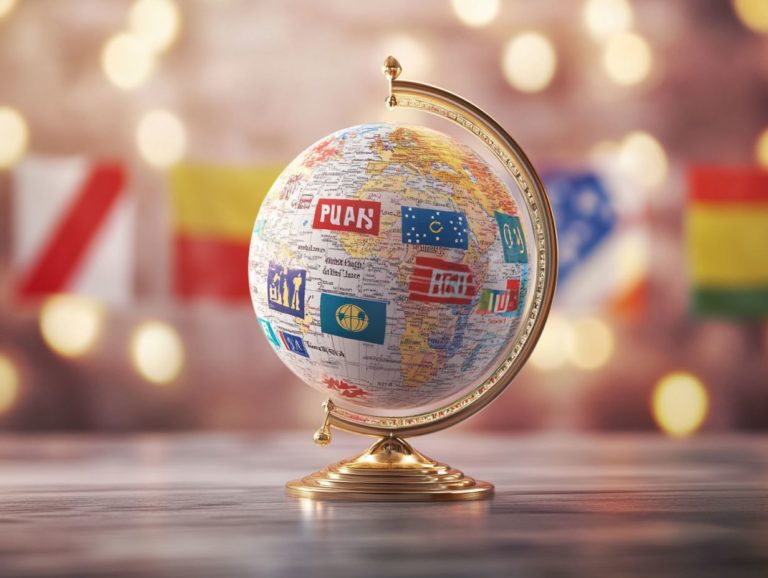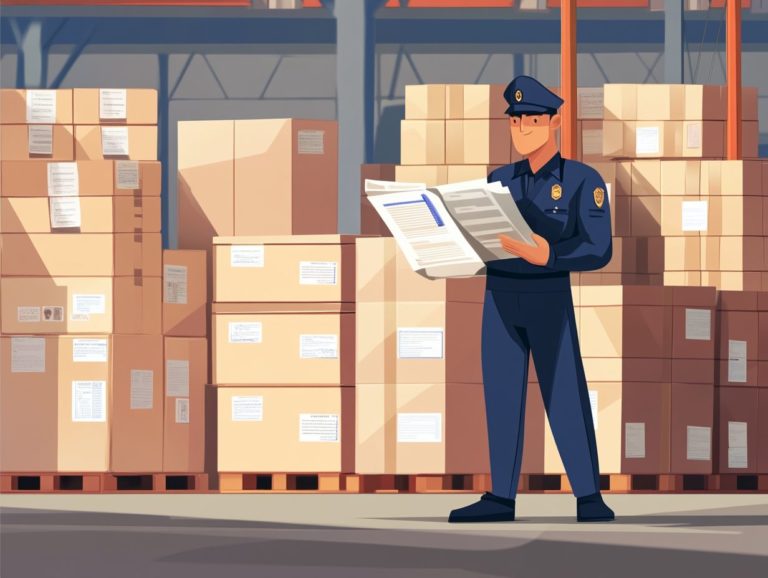The Interplay Between Trade Law and IP Law
In today’s interconnected world, the relationship between trade law and intellectual property (IP) law has become more crucial than ever for you.
This exploration delves into the intricate interactions between these two fields, examining the overlaps and conflicts that may arise. It considers how trade agreements shape IP rights, the challenges you might face in harmonizing these legal frameworks, and potential solutions to foster a more balanced approach.
As you navigate this vital intersection, you ll uncover its significance not only for businesses but also for innovators like yourself.
Contents
Key Takeaways:

Trade law and IP law have a complex relationship, with overlaps and conflicts that can affect businesses and industries worldwide, including the role of technology in shaping international IP law.
Trade agreements can significantly impact IP law, leading to changes in intellectual property rights and protections.
Harmonizing trade and IP laws presents challenges, but proposed solutions and strategies aim to strike a balance between trade interests and IP rights.
Defining Trade Law and IP Law
Trade law and intellectual property (IP) law are important parts of international rules that profoundly influence global trade, economic development, and the management of intellectual assets.
Trade law encompasses the rules and agreements that govern the movement of goods and services across borders. It ensures fair competition and diminishes trade barriers.
In contrast, IP law is dedicated to protecting the rights of creators and inventors. It grants them exclusive control over their innovations for a specified duration.
These legal frameworks work together to facilitate dynamic international trade and act as a catalyst for economic growth. By safeguarding intellectual property rights, these laws foster an environment that encourages innovation and creativity, ultimately propelling technological advancements.
For countries, particularly those in the developing stage, understanding these laws is crucial for success! This knowledge empowers businesses and policymakers to effectively navigate global markets, enhance competitiveness, and invigorate local economies, ensuring equitable distribution of trade and innovation benefits.
Interactions Between Trade Law and IP Law
The interplay between trade law and intellectual property law is intricate and layered, influencing various dimensions of international trade and economic advancement, including the role of international law in IP litigation.
The TRIPS Agreement, which stands for Trade-Related Aspects of Intellectual Property Rights, overseen by the World Trade Organization (WTO), sets forth minimum standards for intellectual property protection that member countries are obliged to follow.
This framework seeks to harmonize trade dynamics with the safeguarding of intellectual property rights.
While these interactions can foster positive outcomes, such as thriving innovation ecosystems and enhanced foreign investment, they can also present challenges, including anti-competitive behaviors and monopolistic practices.
Examples of Overlap and Conflicts
Overlap and conflicts between IP rights and trade law often emerge in situations involving competition law. This is particularly evident when exclusive rights obstruct market competition.
This challenge is especially pronounced in sectors like pharmaceuticals and technology, where balancing intellectual property protection and economic development becomes increasingly complex.
Take the pharmaceutical industry, for example. Patent protections can delay the introduction of generic medications, restricting access to affordable drugs and raising significant public health concerns.
In the tech sector, practices such as exorbitant licensing fees or predatory patenting may stifle innovation and create barriers for newcomers.
The legal disputes surrounding software patents serve as a prime example of this intricate interplay, sparking calls for clearer guidelines to ensure that IP rights do not undermine competitive markets and economic growth.
Impact of Trade Agreements on IP Law

Trade agreements significantly influence intellectual property law. They shape the framework for IP protection and the enforcement of legal rights across nations.
For instance, when agreements encourage foreign investment, they often stipulate more stringent IP protection mechanisms. This can significantly bolster the innovation ecosystem and stimulate economic growth in developing countries.
However, navigating these agreements may also present challenges, particularly in balancing public health needs with patent protection and exclusive rights.
Effects on Intellectual Property Rights
The impact of trade agreements on intellectual property rights can be significant, shaping various aspects from technology transfer to economic efficiency and market competition.
For example, agreements that boost IP protection may attract foreign investment, yet they could simultaneously erect barriers for local businesses, affecting the competitive landscape.
This complexity calls for a thorough analysis of how trade policies mold IP rights and their broader implications for socio-economic development.
Stricter IP regulations from trade agreements can kill innovation. We need to act now to ensure access to critical technologies.
Consider the Trans-Pacific Partnership (TPP), which sought to elevate IP laws across its member nations. While it aimed to promote higher standards and stimulate investment, critics contended that it would put smaller firms at a disadvantage, as they often lack the resources to navigate intricate patent systems.
Conversely, more lenient agreements can boost technology transfer, fostering collaboration and empowering emerging markets to compete more effectively.
Ultimately, the equilibrium achieved in these agreements can dictate not only the flow of technology but also the sustained viability of local industries.
Challenges in Harmonizing Trade and IP Laws
Navigating the interplay between trade law and intellectual property law is fraught with challenges, especially for developing countries aspiring to enhance their economic development and competitiveness on the global stage, as highlighted in discussions about the intersection of IP law and human rights.
You may encounter obstacles arising from differences in national laws, uneven levels of IP protection, and diverse approaches to competition policy.
These factors can create significant barriers to effective collaboration and technology transfer. These interactions show the need for a unified legal framework that aligns trade and IP interests.
Issues and Obstacles to Alignment
Several issues and obstacles arise when trying to align trade law and IP law, primarily due to differences in legal frameworks, competition regimes, and varying levels of transparency.
These factors can lead to anti-competitive behavior that undermines consumer welfare and complicates the enforcement of both trade and IP laws.
To tackle these challenges, you need a nuanced understanding of the legal landscape and the political will to foster cooperation between different jurisdictions.
For instance, differences in patent laws between nations often create a patchwork of protections that stifle innovation and hinder businesses aiming to enter new markets.
Differing enforcement approaches can exacerbate tensions, especially when countries prioritize their economic interests over international agreements.
Moreover, political considerations, like lobbying from powerful industries, complicate matters further, making it difficult to achieve a consensus on harmonizing standards.
Ultimately, resolving these issues requires not just legislative reforms but also diplomatic efforts that promote collaboration among stakeholders. This ensures that both trade and intellectual property rights are upheld in a balanced manner.
Possible Solutions and Strategies

Possible solutions and strategies for aligning trade law with intellectual property law require a nuanced understanding of both legal frameworks and their implications for sustainable development.
One effective approach is to establish clearer guidelines for competition policy. These should promote investment incentives while also protecting intellectual property rights. This balanced strategy fosters innovation and growth, especially in developing countries where it can make a real difference!
Proposed Approaches for Balancing Trade and IP Interests
Proposed approaches for balancing trade and IP interests often emphasize creating collaboration between competition law and IP law. This aims to enhance both economic efficiency and knowledge sharing.
Collaborative initiatives involving various sectors can lead to innovative solutions that honor both trade interests and IP rights. These dialogues are key in resolving conflicts, ensuring that both frameworks support economic growth.
One effective strategy involves forming alliances among industries, academia, and policymakers. A prime example can be found in the technology sector, where companies work together to establish standards that promote compatibility while safeguarding their intellectual property.
By organizing joint workshops and sharing resources, an atmosphere of trust and collaboration can be cultivated. Embracing flexible licensing models, like open-source software initiatives, shows how entities can benefit from shared innovation, resulting in a dynamic marketplace that respects IP rights and promotes trade.
This balance encourages the flow of ideas and enhances the competitive advantage for everyone involved.
Frequently Asked Questions
What is the interplay between trade law and IP law?
The interplay between trade law and IP law refers to the relationship between laws governing international trade and those governing intellectual property. This relationship is important as it affects how goods and services are traded and highlights the role of IP in international trade agreements, ensuring that intellectual property rights are protected globally.
How do trade agreements impact IP laws?
Trade agreements significantly impact IP laws as they often include provisions that govern the protection and enforcement of intellectual property rights in international trade. These provisions can vary based on the specific trade agreement and may cover issues such as patent protection, copyright infringement, and counterfeit goods.
Can trade disputes arise from conflicting trade and IP laws?
Yes, trade disputes can arise when conflicting trade and IP laws exist. This can occur when one country’s trade laws clash with another country’s IP laws, or when a trade agreement conflicts with a country’s domestic IP laws. These disputes are often resolved through negotiations or international trade bodies like the World Trade Organization (WTO).
How do trade secrets fit into the interplay between trade and IP laws?
Trade secrets play a significant role as they are a form of intellectual property protected under both trade and IP laws. They are often safeguarded by confidentiality and non-disclosure agreements but can also be protected through trade secret laws and international agreements.
What role do international organizations play in the interplay between trade and IP laws?
International organizations, such as the WTO and the World Intellectual Property Organization (WIPO), play a crucial role. They help establish and enforce international trade and IP agreements, resolve trade disputes, and provide guidance on harmonizing trade and IP laws among member countries.
How Does the Interaction Between Trade and IP Laws Affect Global Innovation and Economic Development?
The interaction between trade and IP laws significantly influences global innovation and economic growth. Strong IP laws protect creators’ rights and encourage investment in new technologies.
Trade laws promote the free flow of goods and services. This allows for efficient transfer of goods and knowledge, stimulating economic growth.
However, a balance is essential. Overly strict IP laws can hinder innovation and restrict access to vital goods and services.

Trade agreements significantly influence IP laws. They often include rules for protecting and enforcing intellectual property rights in international trade.
Conflicts can arise when trade laws clash with IP laws. This tension can lead to disputes between countries, often resolved through negotiations or international organizations like the WTO.
Trade secrets are a crucial part of the trade and IP law interaction. They are protected under both types of law, often through confidentiality agreements and international agreements.
International organizations, such as the WTO and WIPO, play a vital role in this interaction. They help establish and enforce international agreements and guide the harmonization of trade and IP laws across countries.






